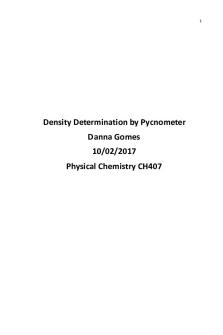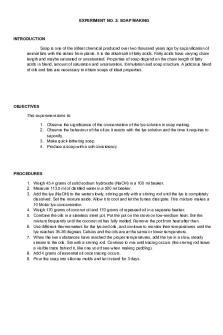Density pycnometer - Laboratory report PDF

| Title | Density pycnometer - Laboratory report |
|---|---|
| Author | Danna Gomes |
| Course | Physical Chemistry I: Thermodynamics |
| Institution | Pace University |
| Pages | 9 |
| File Size | 148.6 KB |
| File Type | |
| Total Downloads | 75 |
| Total Views | 159 |
Summary
Laboratory report...
Description
1
Density Determination by Pycnometer Danna Gomes 10/02/2017 Physical Chemistry CH407
2
Abstract: Using the pycnometer method we were able to determine the density of copper solid and acetone and isopropyl alcohol liquids. To determine that we used the ratio of ρ=m/V, where m is the weight of the materials and V is the volume hat is filling the pycnometer and the stopper (temperature dependent values of density ρH2O).
Introduction: Density is an elementary physical property of matter. It is defined as the ratio of mass to volume of a substance. Pycnometry is a technique that uses the density relationship between volume and mass, and vessel used is called a pycometer. In any density determination, two quantities are measured: the mass and the volume of given quantity of matter. The quantity we usually think of as weight is really the mass of a substance. The mass of a sample of liquid in a pycnometer can be found by taking the difference between the mass of pycnometer plus the liquid and the mass of the empty pycnometer. Same thing for solids. The volume of an object increases with increasing temperature, because of the matter’s volumetric thermal expansion. When heat is applied on a body, its volume expands proportional to the original volume or the change in temperature in the body. Liquids in general, expand on heating. However water is an exception to this general behavior: below 4 °C it contracts on heating. For higher temperature it shows the normal positive thermal expansion. The thermal expansion of liquid is usually higher than in solids because of weak intermolecular forces present in liquids.
3
Background: In this experiment we can determine the density of a liquid and a solid by procedures involving the determination of the mass of a sample together with its volume. We can determine this value by using the formula ρ=m/v. We can also determine in this experiment how volume is a function of temperature and mass is also a function of temperature. In this experiment pressure is negligible because we will not deal with any gas, only with liquids and a solid. The liquids and solid are known and later we will compare our results to its true value. We also are going to do a trial with a liquid using no gloves, so that way we can see how temperature can interfere at the density of this liquid. It is also important to point out that mass can decrease due to the liquid’s volatilization, which also interferes at its density.
Experimental procedure: Do not handle your experimental without gloves; Determine the weight of empty, dry pycnometer m0 ; Fill about 1/3 of pycnometer volume with objects made of examined material and measure the weight m1 ; Add water such that pycnometer as well as capillary hole on the stopper is filled with water. Dry pycnometer outside and measure total weight m2 ; Empty pycnometer and filled it with DI water only. Dry pycnometer outside again and measure the weight m3 ;
4
Empty pycnometer. Rinse it once with a liquid whose density you are going to determine next. Fill pycnometer with the liquid as previously and measure the weight m4 ; Repeat step 5 for several different liquid materials ; Clean pycnometer after finishing the experiment. Rinse it with DI water and let it dry ; Measure the laboratory temperature T, which determines the temperature of examined liquids and solid objects ; Calculate the weight of water mH2O= m3-m0, weight of measured liquid mL= m4-m0 and determine its density according to given equation. Repeat this calculation for all measured liquids ; In next, calculate the weight of solid object mS= m1-m0 and weight of “added” water m’H2O=m2-m1 ; Calculate object’s volume VS and ρS ; Using given equations, find the density of your unknown liquids ; Find the volume of the pycnometer VPYC= mH2O/dTEMP Look up the density of the substances and compare with literature. Do your percent error.
5
Results: The liquids and solid are known. We used copper beads for solid and acetone and isopropyl alcohol for liquids. That way we can compare our final results with their true values. During the measurements of these liquids, their weights were going off too much due to their volatilization. Because that happened we had to wait a little bit until it stabilized again. We also did a trial holding the pycnometer with isopropyl alcohol without gloves and measured its weight. m0= mass of pycnometer m1= pycnometer + solid m2= pycnometer + solid + added water m3= pycnometer +water (no solid) m4= pycnometer + acetone m5= pycnometer + isopropyl alcohol m6= pycnometer +isopropyl alcohol (without gloves)
For liquid: V= mH2O/ρH2O
ρL= mL/mH2O *ρH2O
For solid: V’H2O= m’H2O/ρH2O
ρS= mS/ VS
6 Table 1. Temperature dependence of DI water density ρH2O
ΡH2O [ g/cm3]
t [° C] 15 16 17 18 19 20 21 22 23 24 25
0.99996 0.99994 0.99990 0.99985 0.99978 0.99820 0.99799 0.99777 0.99754 0.99730 0.99705
Table 2. Data of the experiment m0 [ g] m1 [ g] m2 [ g] m3 [ g] mH20 [ g]
24.997 3
ρH2O at 20 °C [g/cm ] V’H2O [cm3] m4 [ g] m5 [ g] m6 [ g] mS [ g]
24.199 38.932 38.780 38.646 7.066
19.128 26.194 50.350 44.125 m’H2O [ g] 0.99820 VPYC [cm3] mL [ g] mL [ g] mL [ g] VS [cm3]
24.156 25.042 19.804 19.652 19.518 0.843
ρ4[g/cm3] ρ5[g/cm3] ρ6[g/cm3] ρS[g/cm3]
0.790 0.784 0.7794 8.381
7
Density x Temperature 22.5 22 21.5
T
21 20.5 20 19.5 19 0.78
0.78
0.78
0.78
0.79
0.79
0.79
0.79
ρ
Percent error copper solid: 8.381-8.960/8.960*100= 64% Percent error acetone: 0.790-0.79/0.79*100=0% Percent error isopropyl alcohol: 0.784-0.786/0.786= 0.25%
Discussion: As we said before, density is defined as the ratio of mass to volume of a substance, but temperature can also be an important factor to determine density. As the temperature increases, the density of a substance will decrease. When the volumetric thermal expansion occurs, the volume of the substance increases while its mass is remained. Thermal expansion is the tendency of matter to change in volume in response to a change in temperature. Atoms and molecules in a solid, for instance, constantly oscillate around its equilibrium point. This kind of excitation is called thermal motion. When a substance is heated, its constituent
8
particles begin moving more, thus maintaining a greater average separation with their neighboring particles. Expansion of liquids is much greater than that of solids. A liquid is heated in a container. Heat flows through the container to the liquid. This means that the container expands first, due to which the level of the liquid falls. When the liquid gets heated, it expands more and beyond its original level. We cannot observe the intermediate state. We can only observe the initial and the final levels. This observed expansion of the liquid is known as the apparent expansion of the liquid. Therefore, we can prove how temperature, volume and density are defined as state functions, because a substance's density is not affected by how the substance is obtained. Consider a quantity of water: it does not matter whether that water is obtained from the tap, from a well, or from a bottle, because as long as all three are in the same state, they have the same density. That also works for temperature and volume.
Conclusion: The purpose of this experiment was to determine the density of two known liquids and one know solid and later, compare our final results to the literature. The known liquids were acetone and isopropyl alcohol with density of 0.79 g/cm3 and 0.786 g/cm3 respectively, at 20 °C. The known solid was copper beads with density of 8.96 g/cm3. We got pretty close from the true value for all the materials and with trial m6 we were able to see how the volumetric thermal expansion is true and how volume is dependent of temperature in this case. And also because acetone and isopropyl alcohol are two very volatile we need to remember that their
9
masses can decrease and that was exactly what happened during their measurements, but the final results were not affected....
Similar Free PDFs

Density Lab Report
- 7 Pages

Density lab report
- 17 Pages

Stomatal Density Lab Report
- 6 Pages

Lab 1 - Laboratory Report
- 10 Pages

Laboratory+report+1-4
- 11 Pages

Laboratory 11 - Lab Report
- 3 Pages

Laboratory report - aspirin
- 8 Pages

Laboratory Report 1 SKO3023
- 30 Pages

Laboratory Report Rubric
- 2 Pages
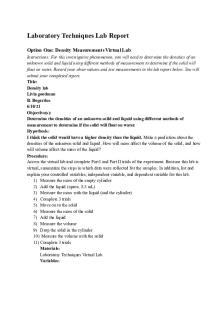
Laboratory Techniques Lab Report
- 4 Pages

LABORATORY REPORT EXPERIMENT 5
- 6 Pages

Laboratory report for BIO
- 4 Pages
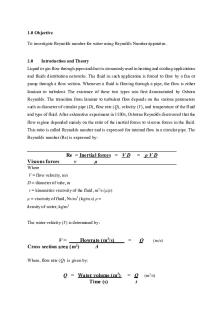
Reynold\'s Number Laboratory Report
- 11 Pages
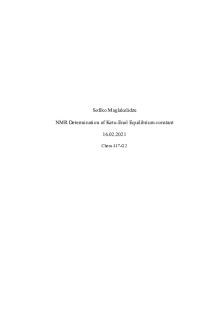
NMR Laboratory Report
- 17 Pages
Popular Institutions
- Tinajero National High School - Annex
- Politeknik Caltex Riau
- Yokohama City University
- SGT University
- University of Al-Qadisiyah
- Divine Word College of Vigan
- Techniek College Rotterdam
- Universidade de Santiago
- Universiti Teknologi MARA Cawangan Johor Kampus Pasir Gudang
- Poltekkes Kemenkes Yogyakarta
- Baguio City National High School
- Colegio san marcos
- preparatoria uno
- Centro de Bachillerato Tecnológico Industrial y de Servicios No. 107
- Dalian Maritime University
- Quang Trung Secondary School
- Colegio Tecnológico en Informática
- Corporación Regional de Educación Superior
- Grupo CEDVA
- Dar Al Uloom University
- Centro de Estudios Preuniversitarios de la Universidad Nacional de Ingeniería
- 上智大学
- Aakash International School, Nuna Majara
- San Felipe Neri Catholic School
- Kang Chiao International School - New Taipei City
- Misamis Occidental National High School
- Institución Educativa Escuela Normal Juan Ladrilleros
- Kolehiyo ng Pantukan
- Batanes State College
- Instituto Continental
- Sekolah Menengah Kejuruan Kesehatan Kaltara (Tarakan)
- Colegio de La Inmaculada Concepcion - Cebu
